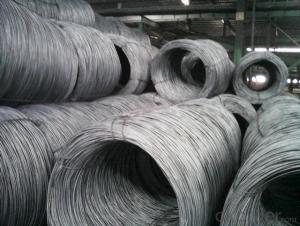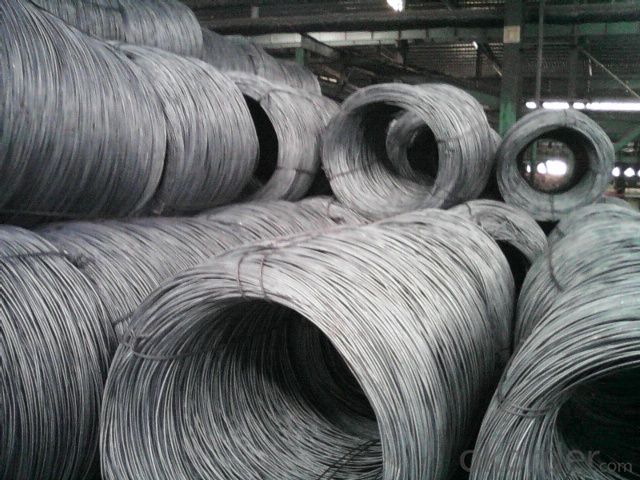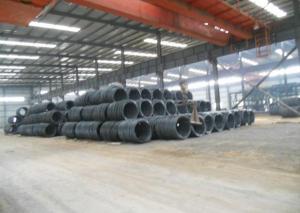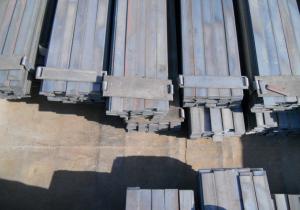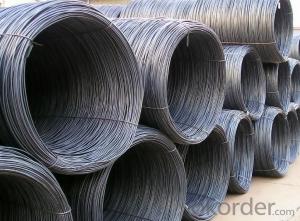Q235 Steel Wire Rod
- Loading Port:
- China Main Port
- Payment Terms:
- TT OR LC
- Min Order Qty:
- -
- Supply Capability:
- -
OKorder Service Pledge
OKorder Financial Service
You Might Also Like
Specifications of Wire Rod Q235:
Grade: Q235 Standard: GB
Diameter: 5.5mm, 6.5mm, 7mm, 8mm, 9mm, 10mm, 11mm, 12mm
Alloy or Not: Alloy
Technique: Hot Rolled Place of Origin: China Mainland
Chemical Composition:
Please kindly find our chemistry of our material based on Q235 as below for your reference:
Trademark | Rank | Chemical composition (quality score) % | | ||||
C | Si | Mn | S | P | | ||
| | |||||||
| ≤ |
| ≤ | ≤ | | ||
Q235 | A | 0.14-0.22 | 0.30 | 0.30-0.65 | 0.050 | 0.045 | |
Q235 | B | 0.12-0.20 | 0.30 | 0.30-0.70 | 0.045 | 0.045 | |
Trademark | Rank | Pulling Test | | ||||
Bend PointΔs/Mpa | Tensile Strength | Elongation Ratioδ5% | | ||||
| | |||||||
Thickness (Diameter) /MM | Thickness (Diameter) /MM | | |||||
≤16 | 16-40 | | ≤16 | 16-40 | | ||
≥ | | ≥ | | ||||
Q235 | A | 235 | 225 | 375-500 | 26 | 25 | |
Q235 | B | 235 | 225 | 375-500 | 26 | 25 | |
Usage and Applications of Wire Rod Q235:
After hot-rolled the products shaped into coil and delivery as finished product, including round, square,rectangular, hexagonal and so on. Since most of the products are round, it is generally called wire rod. Carbon steel wire rod is widely used in construction and manufacturing. Carbon steel wire rod is mainly used for reinforcement of reinforced concrete and welded structure or reprocessed (roberts , nail, etc.) materials, especially used to produce wire drawing, welding electrode, nails, spring, electronic, precise machinery parts and so on.
Packaging & Delivery of Wire Rod Q235:
Packaging Detail: products are packed in coil and then shipped by container or bulk vessel
Each coil weight: About 2.05MT
Delivery Detail: within 45 days after received deposit or LC.
Label: to be specified by customer, generally, each bundle has 1-2 labels
Trade terms: FOB, CFR, CIF
*If you would like to get our price, please inform us the size, standard/material and quantity. Thank you very much for your attention.
- Q: How is steel wire rod used in the manufacturing of wire for solar panels?
- The manufacturing process of wire for solar panels requires steel wire rod, which is carefully selected based on its strength, durability, and conductivity properties. These high-quality wire rods then undergo a series of manufacturing processes to transform them into the necessary wire for solar panels. Initially, the steel wire rod is drawn through a succession of dies to decrease its diameter and increase its length. This wire drawing process is typically carried out using specialized machinery. By repeatedly passing the wire rod through smaller dies, the wire's diameter is reduced while its length is extended. This results in a long and thin wire that is ideal for solar panel applications. Once the wire has been drawn to the desired diameter, it goes through various treatments to enhance its performance and suitability for solar panels. These treatments may involve processes like annealing, where the wire is heated to high temperatures and then gradually cooled. Annealing improves the wire's flexibility, strength, and electrical conductivity. Following the treatment, the wire is meticulously inspected for any defects or imperfections. This quality control step is crucial in meeting the stringent requirements of the solar panel industry. Wires that fail to meet the necessary standards are discarded, while those that pass the inspection undergo further processing. The final step entails applying a protective layer to the wire. This protective coating is typically composed of materials like tin, silver, or copper, which enhance the wire's electrical conductivity and provide corrosion resistance. The coated wire is then wound onto spools or reels, ready for use in assembling solar panels. In conclusion, steel wire rod plays a vital role in the manufacturing process of wire for solar panels. Through wire drawing and annealing, the wire is transformed into a durable and highly conductive form. Coating the wire with protective materials further enhances its electrical properties and resistance to corrosion. Ultimately, this wire is utilized in the construction of solar panels, contributing to the utilization of solar energy and promoting a more sustainable future.
- Q: What are the main factors affecting the market customer service of steel wire rod?
- There are several main factors that can affect the market customer service of steel wire rod. Firstly, the quality and consistency of the product itself play a significant role. Customers expect steel wire rod to meet certain standards in terms of strength, durability, and reliability. Any deviation from these expectations can lead to dissatisfaction and loss of trust. Secondly, timely and efficient delivery is crucial in customer service. Steel wire rod is often used in time-sensitive projects, and delays in shipment can result in costly disruptions. Therefore, reliable logistics and on-time delivery are essential to maintain good customer relationships. Another important factor is customer support and responsiveness. Promptly addressing customer inquiries, concerns, and complaints can significantly impact customer satisfaction. Providing knowledgeable and helpful support can enhance the overall customer experience. Additionally, pricing and competitiveness in the market also affect customer service. If suppliers offer competitive prices and terms, it can attract more customers and foster long-term relationships. Clear and transparent pricing policies can also contribute to a positive customer experience. Ultimately, the main factors affecting the market customer service of steel wire rod revolve around product quality, delivery reliability, customer support, and competitive pricing. By focusing on these aspects, companies can strive to meet customer expectations and build strong relationships in the market.
- Q: What are the disadvantages of using steel wire rod?
- Some disadvantages of using steel wire rod include its susceptibility to corrosion and rusting, its relatively high cost compared to other materials, and its limited flexibility and elasticity compared to other types of wire. Additionally, steel wire rod can be heavy and difficult to handle, making it less suitable for certain applications that require lightweight or flexible wire.
- Q: What are the different impact testing methods for steel wire rod?
- There are several different impact testing methods that can be used to assess the mechanical properties of steel wire rods. These methods help determine how well the wire rods can withstand sudden impact or shock loading, which is crucial in various applications such as construction, automotive, and aerospace industries. Some of the commonly used impact testing methods for steel wire rods include: 1. Charpy Impact Test: This method involves striking a notched or V-notch specimen with a pendulum hammer to measure the energy absorbed during fracture. The test measures the toughness of the material and is widely used due to its simplicity and ease of implementation. The results are typically reported as the energy absorbed in joules. 2. Izod Impact Test: Similar to the Charpy test, the Izod test also measures the energy absorbed during fracture. However, in this method, the specimen is clamped vertically, and the pendulum strikes it at the opposite side of the notch. The test provides information about the material's resistance to sudden impact. 3. Drop Weight Test: In this method, a weight is dropped from a specified height onto a wire rod specimen. The energy absorbed during fracture is measured, and the test is useful in determining the material's ability to withstand impact loading under specific conditions. 4. Dynamic Tear Test: This test evaluates the fracture toughness of steel wire rods by measuring the energy required to propagate a pre-existing crack through the specimen. The test involves applying a load to the specimen, either by a pendulum or a hydraulic system, and monitoring the crack propagation. 5. Ballistic Pendulum Test: This method determines the velocity of a small projectile before and after striking the wire rod specimen. By measuring the change in velocity, the impact resistance of the material can be evaluated. The test is commonly used for high-strength steel wire rods. Each of these impact testing methods has its own advantages and limitations, and the choice of the method depends on various factors such as the specific application, material properties, and test requirements. It is essential to select an appropriate testing method that accurately reflects the intended use of the steel wire rod and ensures its performance and reliability in real-world scenarios.
- Q: What are the different types of steel wire rod coatings used for anti-corrosion properties?
- Steel wire rod coatings are commonly used to prevent corrosion. There are various types of coatings available for this purpose. 1. Zinc Coatings: Zinc coatings, like galvanized coatings, are widely used for their anti-corrosion properties. These coatings create a protective layer of zinc on the steel wire rod surface, acting as a barrier against corrosion. Zinc coatings can be applied through hot-dip galvanizing or electroplating. 2. Aluminum Coatings: Another type of coating used for anti-corrosion is aluminum coatings. These coatings can be applied through hot-dip aluminizing or thermal spraying. They form a protective layer that prevents contact between the steel wire rod and corrosive substances. 3. Epoxy Coatings: Epoxy coatings, a type of organic coating, are commonly used for anti-corrosion purposes. They are applied as a liquid and then cured to create a hard and durable protective layer on the steel wire rod surface. Epoxy coatings offer excellent resistance against corrosion and can withstand harsh environments. 4. Polymer Coatings: Polymer coatings, such as polyethylene or polypropylene coatings, are frequently used for anti-corrosion properties. These coatings are typically applied through extrusion or powder coating. Polymer coatings provide a protective layer that is resistant to chemicals, moisture, and other corrosive elements. 5. Ceramic Coatings: Ceramic coatings are highly resistant to corrosion and wear. They are applied through thermal spraying or chemical vapor deposition. Ceramic coatings create a hard and dense layer on the steel wire rod surface, offering excellent protection against corrosion. Choosing the right coating depends on factors such as the environment, operating conditions, and desired level of corrosion resistance. Each type of coating has its own advantages and limitations, so it is crucial to select the most suitable one for long-term anti-corrosion protection of the steel wire rod.
- Q: How is steel wire rod used in the manufacturing of wire rope chains?
- Steel wire rod is the raw material that is used to manufacture wire rope chains. It is first drawn through a series of dies to reduce its diameter and increase its tensile strength. The resulting wire is then twisted and braided together to form the strands of the wire rope chain. This process ensures that the wire rope chain is strong, durable, and able to withstand heavy loads and harsh conditions.
- Q: What are the advantages of using galvanized steel wire rod?
- There are several advantages of using galvanized steel wire rod. Firstly, galvanized steel wire rod has a high level of corrosion resistance. This is due to the zinc coating that is applied to the surface of the wire rod. The zinc acts as a protective barrier, preventing rust and corrosion from forming on the steel. This makes galvanized steel wire rod suitable for outdoor applications, where it may be exposed to moisture and harsh weather conditions. Secondly, galvanized steel wire rod is incredibly durable. The zinc coating adds an extra layer of protection to the steel, making it more resistant to wear and tear. This means that galvanized steel wire rod can withstand heavy loads and is less likely to break or deform under stress. This durability makes it ideal for use in construction, fencing, and other demanding applications. Another advantage of galvanized steel wire rod is its versatility. It can be easily bent, twisted, and cut to suit various applications. This makes it a popular choice for a wide range of industries, including agriculture, automotive, and manufacturing. Galvanized steel wire rod can be used for making fences, wire mesh, springs, and various other products. Additionally, galvanized steel wire rod is cost-effective. While the initial cost of galvanizing the wire rod may be higher compared to other types of steel, the long-term benefits outweigh the upfront investment. The corrosion resistance and durability of galvanized steel wire rod mean that it requires less maintenance and has a longer lifespan, reducing the need for frequent replacements. Lastly, galvanized steel wire rod is environmentally friendly. The zinc coating used in the galvanizing process is non-toxic and recyclable. This means that galvanized steel wire rod can be easily recycled at the end of its lifespan, reducing waste and minimizing its impact on the environment. In conclusion, the advantages of using galvanized steel wire rod include high corrosion resistance, durability, versatility, cost-effectiveness, and environmental friendliness. These qualities make it a preferred choice for various applications in different industries.
- Q: How is steel wire rod tested for resistance to crevice corrosion?
- Steel wire rod is typically tested for resistance to crevice corrosion by subjecting it to a series of controlled laboratory experiments. These experiments involve creating crevices on the surface of the wire rod and then exposing it to corrosive environments, such as seawater or acidic solutions. The wire rod is evaluated for any signs of corrosion, such as pitting or localized damage, and its performance is compared to established standards or specifications. Various testing methods, including electrochemical techniques and visual inspections, are employed to ensure that the wire rod meets the required resistance to crevice corrosion.
- Q: How is steel wire rod used in the production of wire mesh for industrial filtration systems?
- Steel wire rod is used in the production of wire mesh for industrial filtration systems as it serves as the raw material for creating the mesh structure. The wire rod is first drawn and processed into various diameters and gauges to achieve the desired strength and flexibility for the wire mesh. These wires are then woven or welded together to form a mesh pattern, creating a sturdy and durable filtration system capable of withstanding high temperatures and pressures.
- Q: How is steel wire rod used in the manufacturing of wire forms for fire protection systems?
- Steel wire rod is an essential component in the manufacturing of wire forms for fire protection systems. These wire forms are used in various fire protection applications, such as sprinkler systems, fire extinguishers, and fire alarm systems. Firstly, steel wire rod is used to produce the wire mesh that is often used as a reinforcement in fire-resistant materials. This wire mesh is incorporated into fire-resistant panels, curtains, or barriers to provide additional strength and stability. It helps to prevent the spread of fire by containing it within a designated area. Additionally, steel wire rod is used to manufacture the wires that are used in fire sprinkler systems. These wires are bent and shaped into specific forms, such as U-shapes or loops, which are then attached to sprinkler heads. The wire forms act as a support system, holding the sprinkler heads in place and ensuring that they are properly positioned to discharge water when triggered by heat or smoke. Moreover, steel wire rod is also utilized in the production of wire forms for fire extinguishers. The wire forms are bent and formed into brackets or handles that securely hold the extinguisher cylinder. These wire forms ensure that the fire extinguisher is easily accessible and can be quickly grabbed in emergency situations. Finally, steel wire rod is used in the manufacturing of wire forms for fire alarm systems. These wire forms are shaped into brackets or clips that securely hold the fire alarm devices, such as smoke detectors or heat sensors, in place. The wire forms ensure that the alarm devices are properly positioned to detect and alert occupants of a potential fire hazard. In summary, steel wire rod plays a crucial role in the manufacturing of wire forms for fire protection systems. It is used to produce wire mesh for fire-resistant materials, wires for sprinkler systems, brackets for fire extinguishers, and clips for fire alarm systems. By utilizing steel wire rod in the production process, fire protection systems are enhanced, ensuring the safety of people and property in case of a fire emergency.
Send your message to us
Q235 Steel Wire Rod
- Loading Port:
- China Main Port
- Payment Terms:
- TT OR LC
- Min Order Qty:
- -
- Supply Capability:
- -
OKorder Service Pledge
OKorder Financial Service
Similar products
Hot products
Hot Searches
Related keywords
